
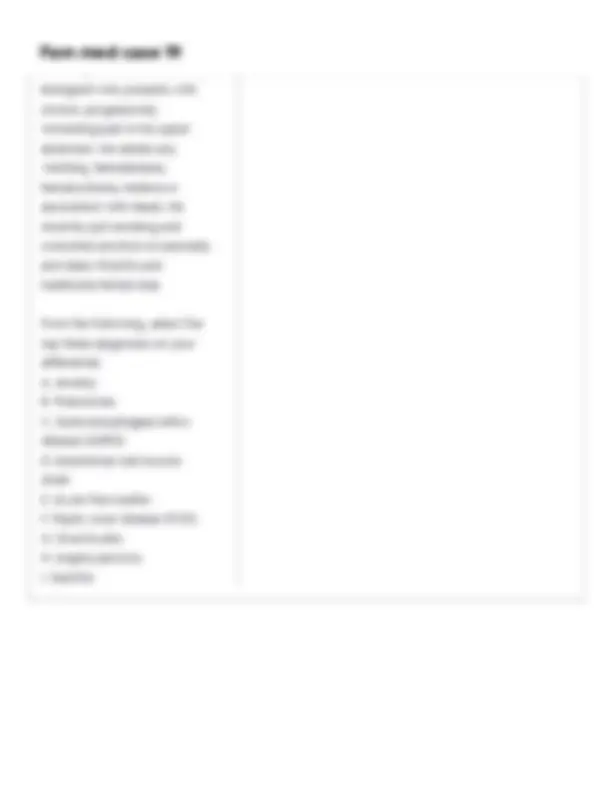
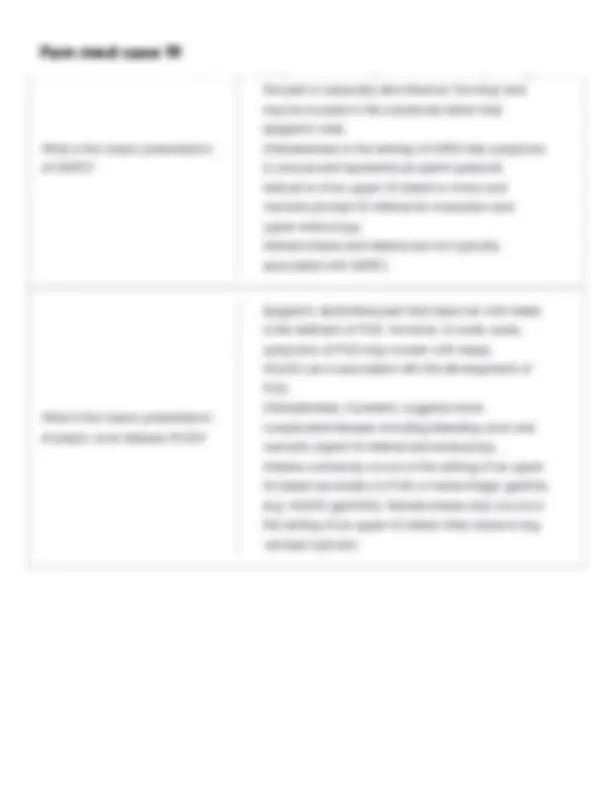
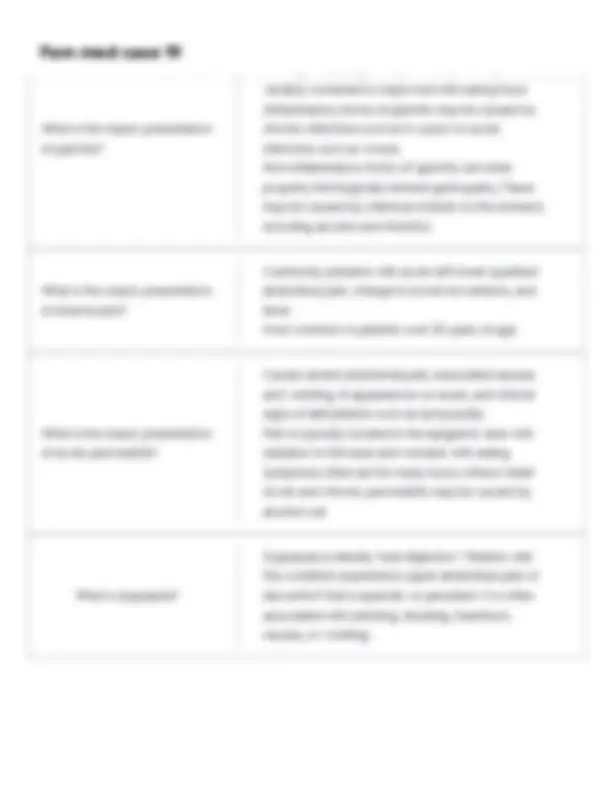
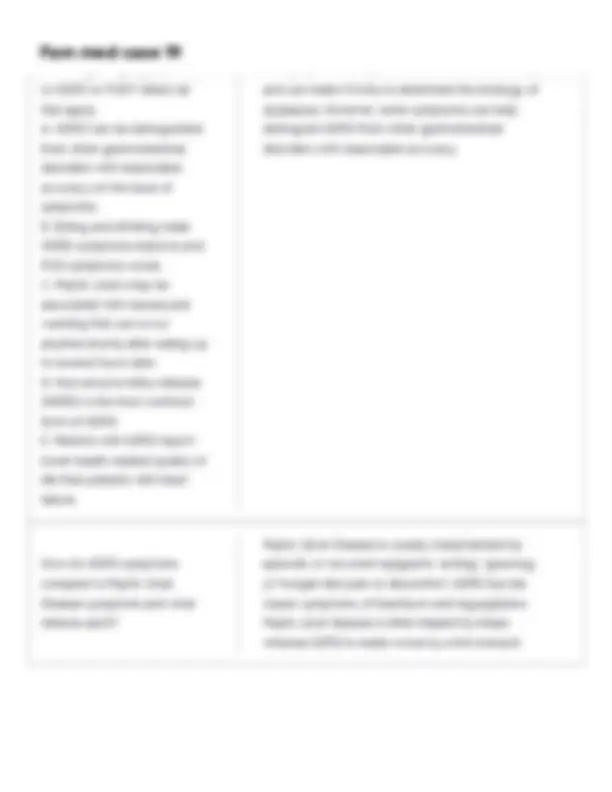
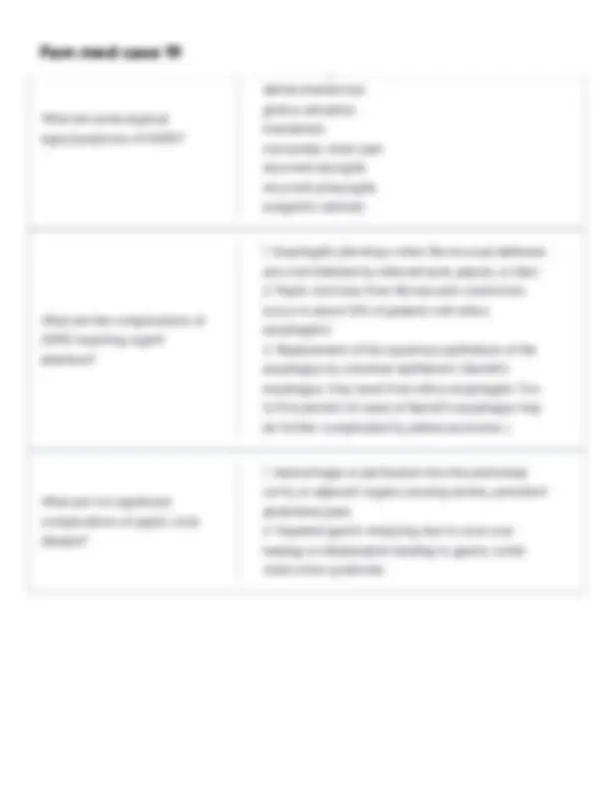
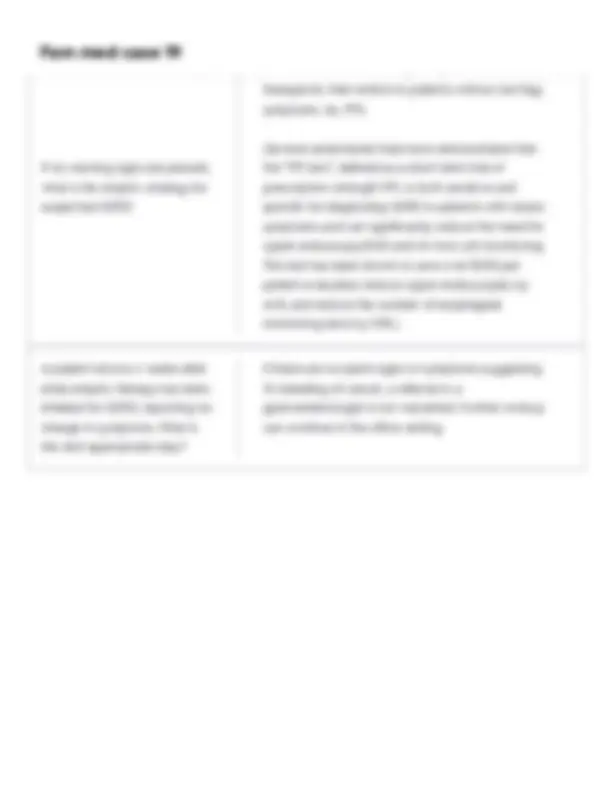
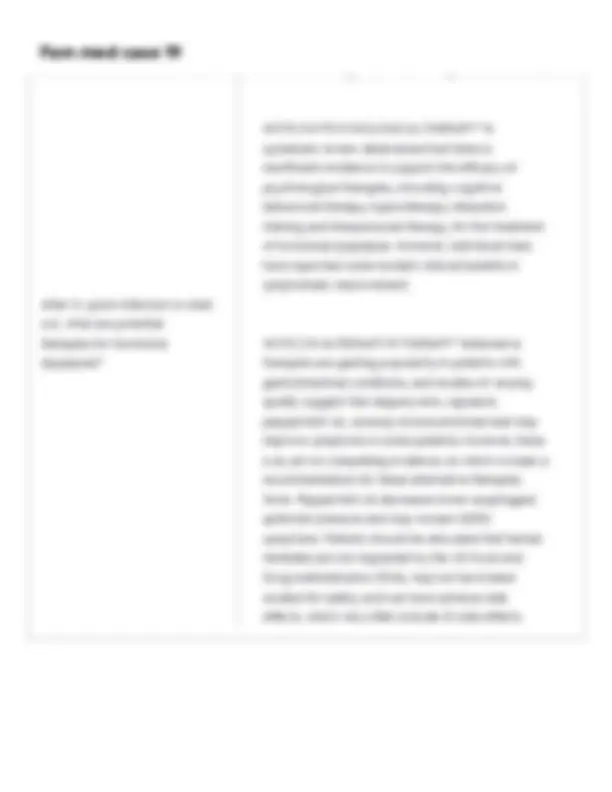
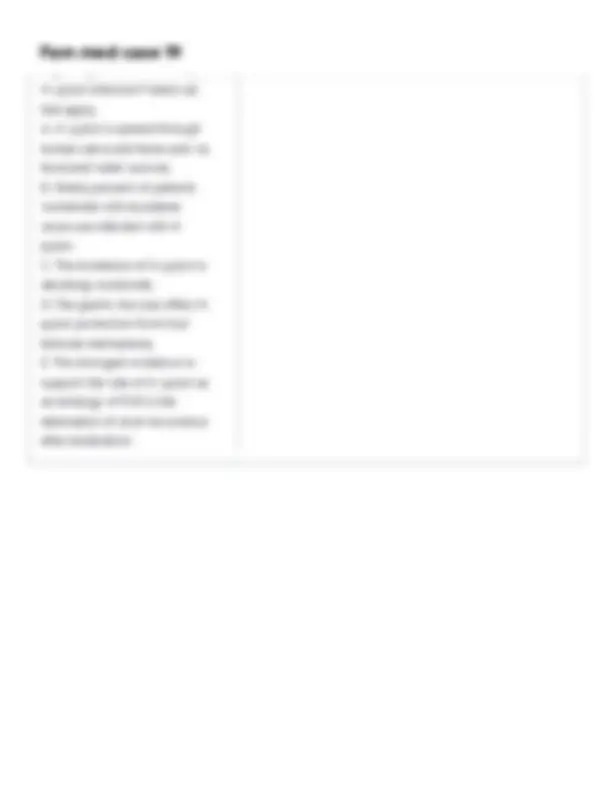

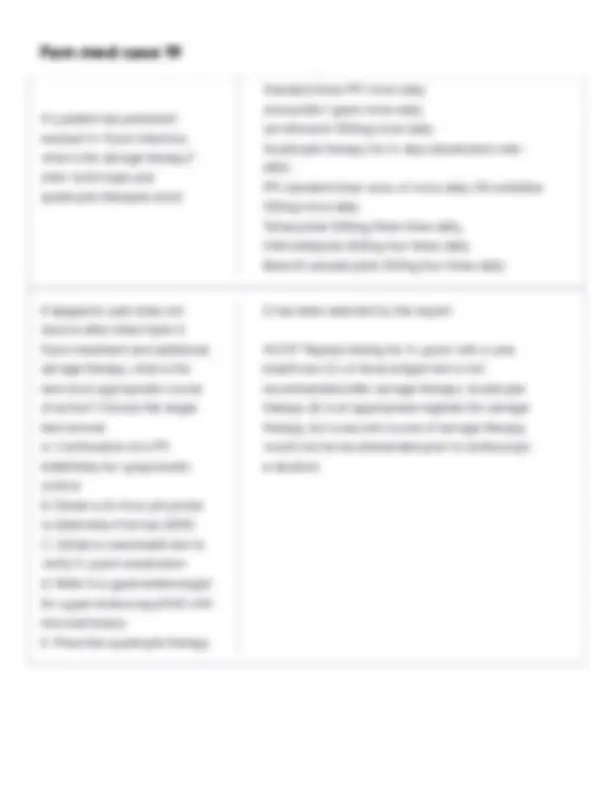
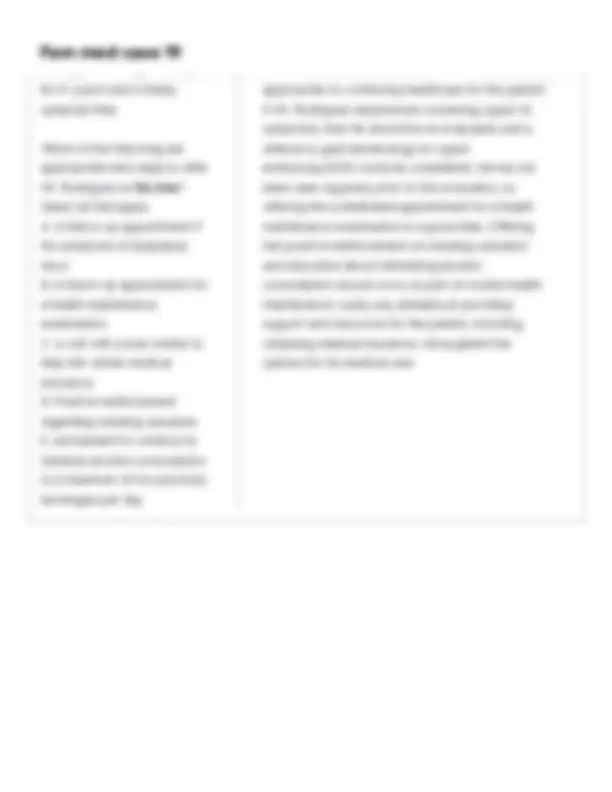
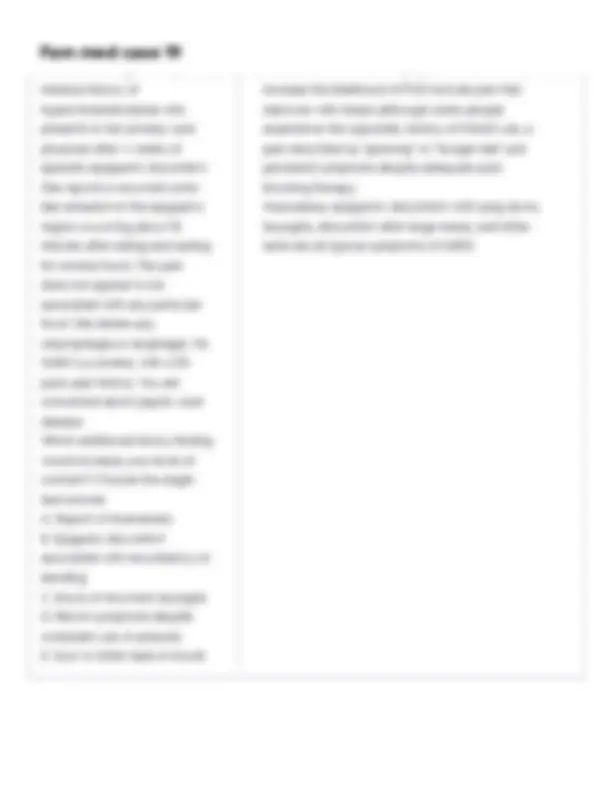
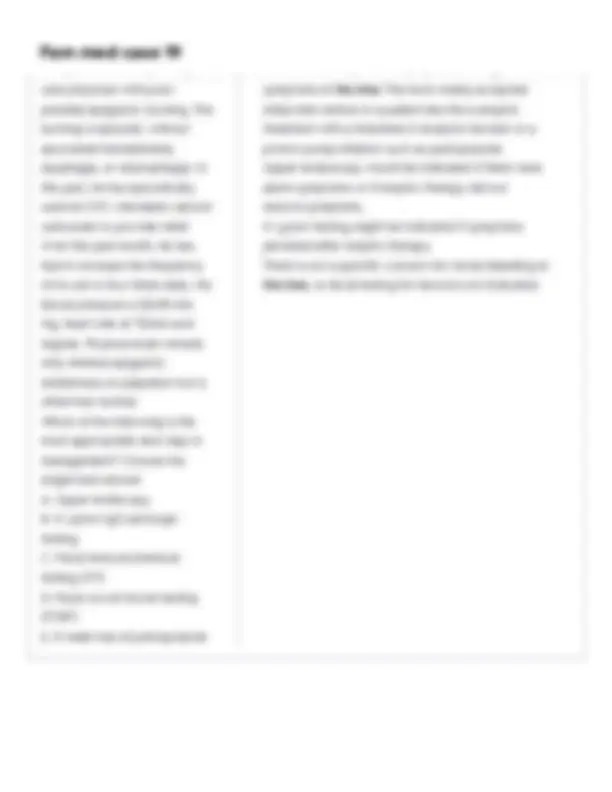
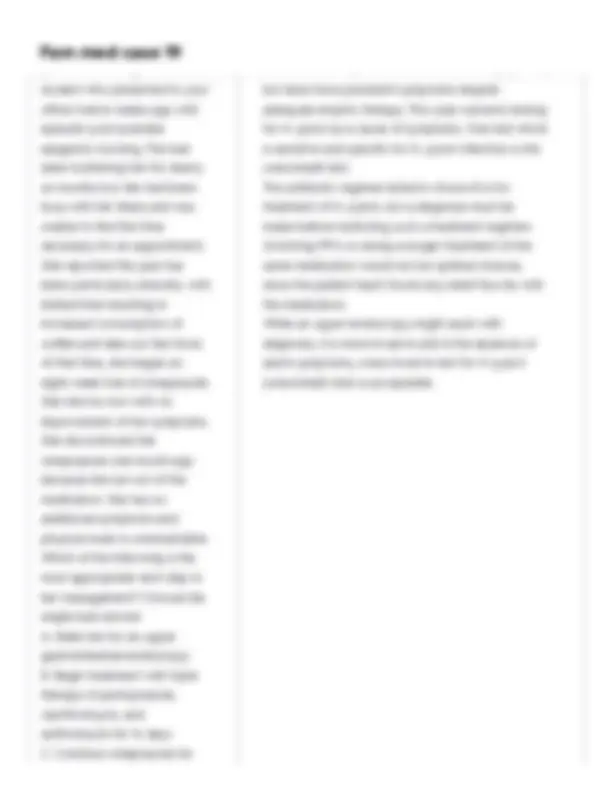

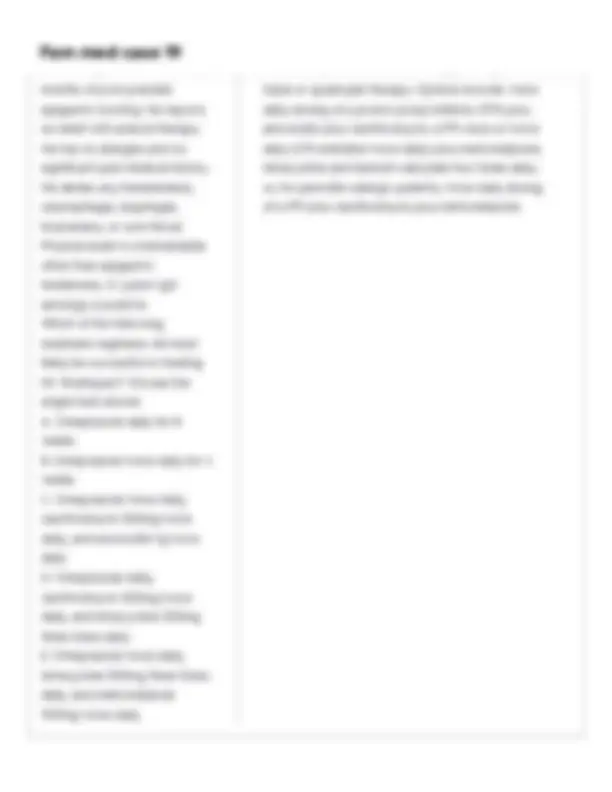
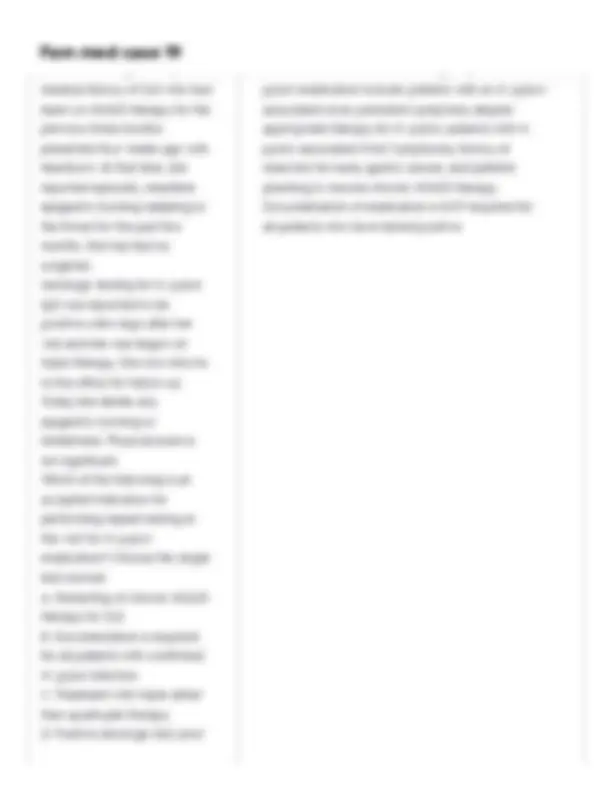



Study with the several resources on Docsity

Earn points by helping other students or get them with a premium plan


Prepare for your exams
Study with the several resources on Docsity

Earn points to download
Earn points by helping other students or get them with a premium plan
Community
Ask the community for help and clear up your study doubts
Discover the best universities in your country according to Docsity users
Free resources
Download our free guides on studying techniques, anxiety management strategies, and thesis advice from Docsity tutors
Family Medicine 19: 39-year-old male with epigastric pain Mr. Rodriquez's case study answers in addition to finances, what are the common reasons for immigrants to avoid seeking medical care? select all that apply
Typology: Exercises
1 / 26

This page cannot be seen from the preview
Don't miss anything!



















5.0 (1 review)
What are potential GI causes of abdominal pain? Appendicitis, cholecystitis/cholelithiasis, diverticulitis/diverticulosis, dyspepsia, gastroesophageal reflux disease, gastritis, acute or chronic hepatic failure with resultant complications (e.g., ascites), acute hepatitis (e.g., viral, autoimmune, alcoholic, drug-induced), inflammatory bowel disease, intestinal ischemia, intestinal obstruction, irritable bowel syndrome, pancreatitis, peptic ulcer, perforation/peritonitis (e.g., gastric, colonic, intestinal), gastric outlet obstruction, tumor (e.g., gastric, hepatic, pancreatic, intestinal, colonic). What are potential cardiac causes of abdominal pain? Myocardial infarction, angina pectoris, abdominal aortic aneurysm dissection or rupture. What are potential Psychogenic causes of abdominal pain? Anxiety, panic disorder, somatiform disorder, post- traumatic stress disorder. What are potential pulmonary causes of abdominal pain? Pleurisy, pneumonia, pulmonary infarction, tumor. What are potential renal causes of abdominal pain? Nephrolithiasis, pyelonephritis, cystitis, tumor.
What are potential musculoskeletal causes of abdominal pain? Abdominal wall muscle strain, hernia (e.g., ventral, inguinal, incarcerated), abscess (e.g., psoas, subphrenic), trauma (e.g., contusion, hematoma). What are potential metabolic causes of abdominal pain? Drug overdose, ketoacidosis, iron or lead poisoning, uremia. What are non-organ based considerations for causes of abdominal pain? medication, vitamin, and herbal supplement side effects foods issues (dietary intolerances, such as lactose, gluten, fructose, or artificial sweeteners (e.g., sorbitol, xylitol, sucralose) Which factors, in addition to finances, may have contributed to Mr. Rodriguez not seeking medical care in the recent months? Select all that apply. A. He may be an undocumented immigrant. B. Undocumented immigrants in the US are at a higher risk of exploitation than legal residents. C. Lack of concern about his overall health. D. His impression that allopathic care is not considered holistic. E. His culture highly values masculinity. F. He may view the US healthcare system as unfriendly and intimidating. A, B, D, E, F have been selected by the expert. Fam med case 19
What is the classic presentation of GERD?
What is the classic presentation of gastritis? Inflammation or irritation of the stomach lining often causing sharp epigastric pain. This pain may be variably worsened or improved with eating food. (Inflammatory forms of gastritis may be caused by chronic infections such as H. pylori or acute infections such as viruses. Non-inflammatory forms of 'gastritis' are more properly histologically termed gastropathy. These may be caused by chemical irritants to the stomach, including alcohol and NSAIDs.) What is the classic presentation of diverticulitis? Commonly presents with acute left lower quadrant abdominal pain, change in bowel movements, and fever. Most common in patients over 50 years of age. What is the classic presentation of acute pancreatitis? Causes severe abdominal pain, associated nausea and vomiting, ill appearance on exam, and clinical signs of dehydration such as tachycardia. Pain is typically located in the epigastric area with radiation to the back and worsens with eating. Symptoms often last for many hours without relief. Acute and chronic pancreatitis may be caused by alcohol use. What is dyspepsia? Dyspepsia is literally "bad digestion." Patients with this condition experience upper abdominal pain or discomfort that is episodic or persistent. It is often associated with belching, bloating, heartburn, nausea, or vomiting. Fam med case 19
What is the relationship between cigarette smoking and peptic ulcer disease? There is no evidence to support a cause-and-effect association between cigarette smoking and PUD. However, cigarette smoking does decrease vascularity to gastric mucosal cells, resulting in decreased rates of mucosal healing after insult, and in combination with NSAID use or H. pylori infection, increases the risk of ulceration. When should we initiate treatment for stress ulcer prophylaxis? Stress ulcer prophylaxis should be considered only for patients with specific conditions. (ie, mechanical ventilation, head injury, hepatectomy, transplantation, sepsis, ICU stay of greater than 1 week, etc) Fam med case 19
Which of the following are TRUE regarding dyspepsia due to GERD or PUD? Select all that apply. A. GERD can be distinguished from other gastrointestinal disorders with reasonable accuracy on the basis of symptoms. B. Eating and drinking make GERD symptoms improve and PUD symptoms worse. C. Peptic ulcers may be associated with nausea and vomiting that can occur anytime shortly after eating up to several hours later. D. Non-erosive reflux disease (NERD) is the most common form of GERD. E. Patients with GERD report lower health-related quality of life than patients with heart failure. A, C, D, E have been selected by the expert. The symptoms that patients describe often overlap and can make it tricky to determine the etiology of dyspepsia. However, some symptoms can help distinguish GERD from other gastrointestinal disorders with reasonable accuracy. How do GERD symptoms compare to Peptic Ulcer Disease symptoms and what relieves each? Peptic Ulcer Disease is usually characterized by episodic or recurrent epigastric 'aching', 'gnawing', or 'hunger-like' pain or discomfort. GERD has the classic symptoms of heartburn and regurgitation. Peptic ulcer disease is often helped by meals whereas GERD is made worse by a full stomach Fam med case 19
If no warning signs are present, what is the empiric strategy for suspected GERD An empiric treatment strategy for GERD, gastritis, and PUD is the most widely accepted initial therapeutic intervention in patients without red flag symptoms. (ie, PPI) (Several randomized trials have demonstrated that the "PPI test", defined as a short-term trial of prescription-strength PPI, is both sensitive and specific for diagnosing GERD in patients with classic symptoms and can significantly reduce the need for upper endoscopy/EGD and 24-hour pH monitoring. This test has been shown to save over $350 per patient evaluated, reduce upper endoscopies by 64%, and reduce the number of esophageal monitoring tests by 53%.) A patient returns 4 weeks after initial empiric therapy has been initiated for GERD, reporting no change in symptoms. What is the next appropriate step? If there are no alarm signs or symptoms suggesting GI bleeding of cancer, a referral to a gastroenterologist is not warranted. Further workup can continue in the office setting. Fam med case 19
Emperic therapy has failed on a patient with suspected GERD. PUD is the next most likely diagnosis, but you are still considering functional dyspepsia. Which of the following are appropriate next steps in diagnostic and therapeutic planning? Select all that apply. A. Ask about current NSAID and/or aspirin use B. Perform a digital rectal examination and guaiac-based fecal occult blood test (FOBT) C. Start tricyclic antidepressants to modulate visceral sensation and minimize pain D. Order H. pylori IgG serology E. Order an H. pylori fecal antigen test F. Obtain a complete blood count (CBC) G. Refer for a urease breath test A, B, D, F have been selected by the expert. A. Ask about current NSAID and/or aspirin use B. Perform a digital rectal examination and guaiac- based fecal occult blood test (FOBT) D. Order H. pylori IgG serology F. Obtain a complete blood count (CBC) Fam med case 19
After H. pylori infection is ruled out, what are potential therapies for functional dyspepsia?
Which of the following are true regarding the natural history of H. pylori infection? Select all that apply. A. H. pylori is spread through human saliva and feces and via food and water sources. B. Ninety percent of patients worldwide with duodenal ulcers are infected with H. pylori. C. The incidence of H. pylori is declining worldwide. D. The gastric mucosa offers H. pylori protection from host immune mechanisms. E. The strongest evidence to support the role of H. pylori as an etiology of PUD is the elimination of ulcer recurrence after eradication. Fam med case 19^ Answer: All of the above.
What is "Quadruple therapy" for the eradication of H. Pylori? "Quadruple therapy" for 10 to 14 days (75% to 90% eradication rate): PPI standard dose once or twice daily (OR ranitidine 150 mg twice daily) Metronidazole 250 mg four times daily Tetracycline 500 mg four times daily Bismuth subsalicylate 525 mg four times daily What is an alternative treatment for H. Pylori to consider in patients who are allergic to penicillin? (70% to 85% eradication rate): PPI standard dose twice daily Clarithromycin 500 mg twice daily Metronidazole 500 mg twice daily Fam med case 19
A patient returns after LAC therapy for H. Pylori. He states that his symptoms of dyspepsia initially improved somewhat after finishing the medication, but have since recurred, occurring almost daily. Which of the following options are appropriate next steps in evaluation and treatment? Select all that apply. A. Prescribe a PPI once daily for 4 weeks, then re-evaluate B. Refer for an upper endoscopy/EGD and biopsy C. Obtain an H. pylori fecal antigen test D. Obtain a urea breath test E. Repeat a course of PPI triple therapy for 14 days F. Treat with salvage therapy for resistant H. pylori infection Answer: C and D C. Obtain an H. pylori fecal antigen test D. Obtain a urea breath test If either test is positive, the patient will require re- treatment for a resistant infection, but this should not be given prior to testing for the presence of active H. pylori infection. If both tests are negative, and the patient continues to have symptoms, he should be referred to a gastroenterologist for an upper endoscopy/EGD and mucosal biopsy Fam med case 19
A patient comes in after triple therapy and salvage therapy for H. pylori and is finally symptom free. Which of the following are appropriate next steps to offer Mr. Rodriguez at this time?this time Select all that apply. A. A follow-up appointment if his symptoms of dyspepsia recur B. A follow-up appointment for a health maintenance examination C. A visit with social worker to help him obtain medical insurance D. Positive reinforcement regarding smoking cessation E. Advisement to continue to minimize alcohol consumption to a maximum of two alcoholic beverages per day A, B, C, D, E have been selected by the expert. All of the above statements are reasonable approaches to continuing healthcare for this patient. If Mr. Rodriguez experiences worsening upper GI symptoms, then he should be re-evaluated, and a referral to gastroenterology for upper endoscopy/EGD could be considered. He has not been seen regularly prior to this evaluation, so offering him a dedicated appointment for a health maintenance examination is a good idea. Offering him positive reinforcement on smoking cessation and education about minimizing alcohol consumption should occur as part of routine health maintenance. Lastly, any attempts at providing support and resources for the patient, including obtaining medical insurance, will augment the options for his medical care. Fam med case 19
Ms Smith is a 38-year-old female with a significant past medical history of hypercholesterolemia who presents to her primary care physician after 4 weeks of episodic epigastric discomfort. She reports a recurrent ache- like sensation in the epigastric region occurring about 10 minutes after eating and lasting for several hours. The pain does not appear to be associated with any particular food. She denies any odynophagia or dysphagia. Ms Smith is a smoker, with a 30- pack year history. You are concerned about peptic ulcer disease. Which additional history finding would increase your level of concern? Choose the single best answer. A. Report of hoarseness B. Epigastic discomfort associated with recumbency or bending C. Bouts of recurrent laryngitis D. Return symptoms despite consistent use of antacids E. Sour or bitter taste in mouth D has been selected by the expert. The correct answer is D. Symptoms that would increase the likelihood of PUD include pain that improves with meals (although some people experience the opposite), history of NSAID use, a pain described as "gnawing" or "hunger-like" and persistent symptoms despite adequate acid- blocking therapy. Hoarseness, epigastric discomfort with lying down, laryngitis, discomfort after large meals, and bitter taste are all typical symptoms of GERD. Fam med case 19